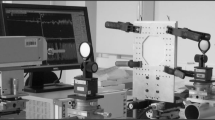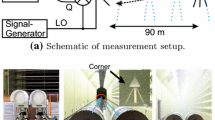Abstract
Computer modeling and analysis techniques have been established to evaluate performance during rain, in a radome-enclosed system. Electromagnetic transmission line theory using raytracing techniques is presented to compute transmission loss. Comparisons between theory and measured results are documented. Variations in water film thickness versus look angle and the resulting effect on performance are discussed. Other performance effects in rain, such as depolarization and noise temperature, are included in the analysis.
The differences in performance using hydrophobic and non-hydrophobic materials can easily be predicted. Hydrophobic membrane materials are available for use with a radome, which yield excellent electromagnetic performance, even at mm wave frequencies. Recent tests are discussed which substantiate enhanced radome performance during rain.
Similar content being viewed by others
References
Gibble, D., “Effect of Rain on Transmission Performance of a Satellite Communication System,” IEEE International Convention Record, Part VI, Mar. 1964, p. 52.
Giger, A.J., “4 Gc Transmission Degradation due to Rain at the Andover, Main Satellite Station,” The BSTJ, Sept. 1968, p. 1528.
Cohen, A. and Smolski, A.P., “The Effect of Rain on Satellite Communication Earth Terminal Rigid Radomes,” Microwave Journal, Sept. 1966, p. 111.
Smolski, A.P., “Transmission Loss of ESSCO Radomes (Wet),” (ESSCO Document D81-12, May, 1981.
Hogg, D. andChu, T. S., “The Role of Rain in Satellite Communications,” IEEE Proc. Vol. 63, No. 9, Sept. 1975, p. 1308–1329.
Mei, C. C., “Rainfall Effect on Rigid Radomes,” ESSCO Document #0082.
Kay, A. andPatterson, D., “Design of Metal Space Frame Radome,” Report #RADC-TRD-64, Rome Air Development Center, Griffiss Air Force Base, New York, p. 36-p. 55, June 1964.
Richmond, J., “Scattering by a Dielectric Cylinder of Arbitrary Cross-Section Shape,” IEEE AP-13, p. 334–341, May 1965.
Richmond, J., “TE-Wave Scattering by a Dielectric Cylinder of Arbitrary Cross-Section Shape,” IEEE AP-14, #4, P.460–464, July 1966.
Rudge, A., et al, “The Handbook of Antenna Design, Volume 2,” Section 14. 7. 4. 1, 1983, Peter Peregrinus Ltd.
Anderson, I., “Measurements of 20-GHz Transmission Through a Radome in Rain,” IEEE Vol AP-22 #5, p. 619–622.
Saxton, J.A., “Dielectric Dispersion in Pure Liquids at Very High Radio Frquencies,” Proc. Roy. Soc. A., Vol. 213, p. 400–408 and p. 473–492, March 1952.
Ray, P.S., “Broadband Complex Refractive Indices of Ice and Water,” App. Opt. Vol. 11, p. 1836–1844, August, 1972.
Author information
Authors and Affiliations
Rights and permissions
About this article
Cite this article
Chang, KC. System performance in rain in a radome-enclosed environment. Int J Infrared Milli Waves 7, 267–289 (1986). https://doi.org/10.1007/BF01013271
Received:
Issue Date:
DOI: https://doi.org/10.1007/BF01013271




